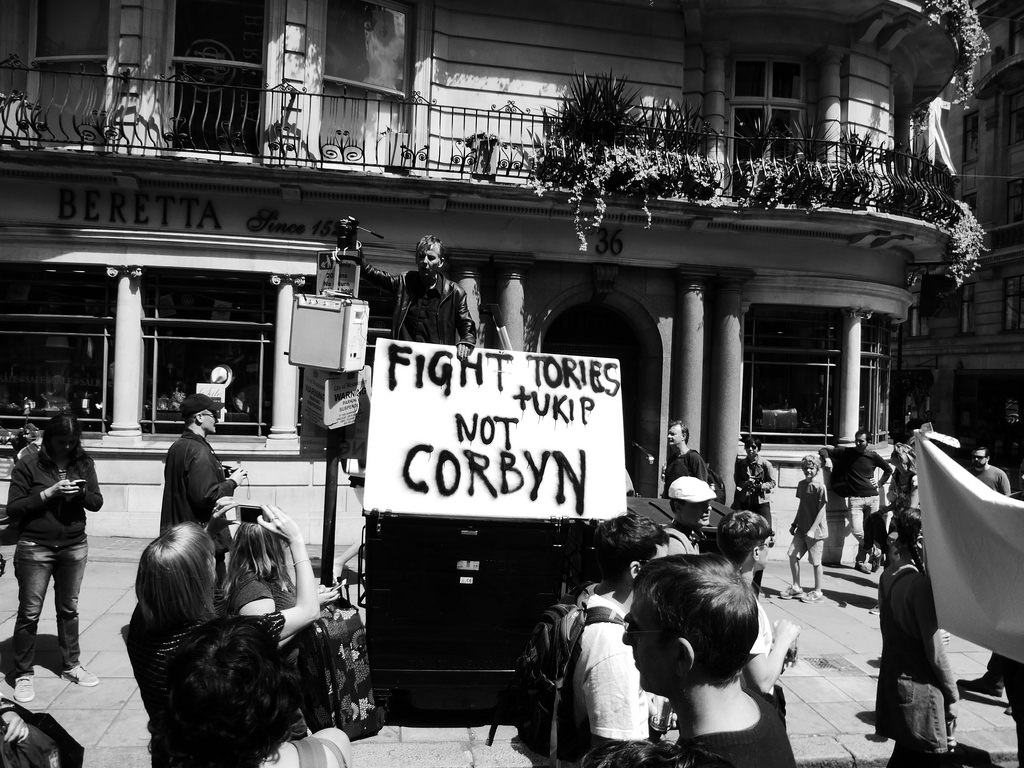New-New Labour: Could the Clash of the Past and Present Force Labour in a New Direction?
by Elizabeth Mizon
8 July 2016

The Labour party is on course to reach a new peak in membership this week as, with all pending applications included, it’s set to hit 600,000 in a flurry of action around various anti-Conservative movements. The previous peak occurred only last week, in a surge that saw a rise to 450,000 members following the EU referendum result and the subsequent thrust of a long-planned coup targeting Jeremy Corbyn.
It’s perhaps tempting to think Labour is making a comeback – but it could be that the left-leaning ‘progressive surge’ ends up causing quite the reverse. That’s not to say, however, that it would be the progressive wing doomed to dog-eared history textbooks.
The motivational jolt of Brexit followed immediately by various political mini-thrillers – Tony Blair’s grilling by the Chilcot report; the resurfacing of Corbyn’s anti-war speeches from 2003; the leadership grab and its backlash; the NHS seeing another birthday (on life-support) – have crystallised the discussions. Who is Old Labour, and who is New Labour – and what do those labels even mean within the soupy mash of political bodies that constitute Labour now?
We may be looking at a downfall of the Labour party – but there are options other than implosion or dissolution. Granted, none of those options look very much like Labour as it appears today – so I guess it depends also on how you define ‘downfall’.
Really – would a Labour split be a bad thing? And for whom?
Would we even feel it?
The majority of those joining Labour are calling for Blairites to pull away from neoliberalism. To stand up for the majority (i.e. people with no and/or ‘normal’ jobs), systemic change and social democracy, rather than foregrounding business interests as the most important node of the economy. New Labour’s subscription to the ‘There Is No Alternative’ school is as out-of-date as a party based entirely around trade unions.
New Labour was overwhelmingly and tragically successful in its aims while MPs such as Corbyn trod water within the re-brand. There’s no reason why remaining Blairites have special privileges to preclude yet another new direction. And especially when a long-fomented uprising is cementing a voice against the ancient but prevailing narrow, white, classist narrative.
But this story has millions of writers – it won’t end neatly in a nice tied bow, and if it did it wouldn’t be with a quick and Blairite-wide redemption. A holistic turn by the parliamentary Labour party away from the last 20 years of the neoliberal Labour party would require Blairites not only to accept that progressives hold them in similar contempt to the Conservatives, but then also change their beliefs accordingly.
This absence of ‘unity’ is the chasm we’re told must be somehow stitched, which seems near impossible. Labour is de facto split already, unified only nominally.
Equally, while trade unions must remain central, their values of collective organising and negotiation are more valuable to today’s world than the protection of any particular industries; in the long-run, radical environmentalism must be more important than saving our steel, for example. The strength of the Labour left is its commitment to the protection of the rights of workers, but any party going forward needs to focus on working people in a fundamental sense, rather than work in a traditional sense.
It seems highly unlikely that either a deeply divided Labour party or a progressive splinter group could achieve this innovation in politics in the time we need it to.
This is where the idea of a new collective leadership, rather than a splinter party, comes in. It seems far more likely that a progressive alliance of the kind proposed by the Greens – also encompassing Plaid Cymru, the Lib Dems and the SNP – has a chance of bringing a unified patchwork of broadly progressive voters together to achieve a progressive parliament, and a future.
The primary risks of a progressive alliance aren’t concerning popularity, but rather its ability also to ensure unification around a set of progressive tenets (and distinguished from both the Conservatives’ idea of ‘progress’ and Labour’s Progress), and that its own particular brand (because, let’s face it, there will be one) will still encompass Labour’s working class base. There’s a likelihood it could end up pandering to the street-partying-because-everything’s-fine-now, well-meaning but still-comfortable middle classes in the name of ‘positivity’ and ‘forward-thinking’.
It requires a transparent, detailed – yet clear – strategy for the near and far futures (like, now, guys, carpe diem?) and/or a manifesto for the next election too, whenever that may arise.
If today’s Labour party is to survive, its MPs and the mainstream media will have to stop dismissing an increasing number of their membership, thousands of ordinary people who happen to be left-of-neocon, as ‘angry Corbynistas’. The made-of-trees newspapers may be privileged to be included in the Westminster bubble, but it limits their ability to be geographically or sentimentally perceptive.
Either way, a glance at Labour’s recent past and potential futures renders the idea of ‘the Labour party’ something of old – at least, if you consider the late-80s to be old.
That doesn’t mean better options can’t be borne of it, of course.
Photo: Duncan C/Flickr
–
If you want to support media for a different politics, you can donate or subscribe to Novara Media at support.novaramedia.com.